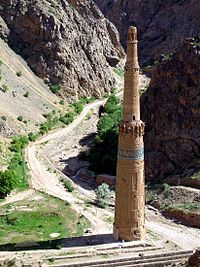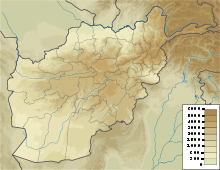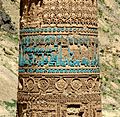- Minaret of Jam
-
Coordinates: 34°23′48″N 64°30′58″E / 34.39667°N 64.51611°E
Minaret and Archaeological Remains of Jam * UNESCO World Heritage Site
Country Afghanistan Type Cultural Criteria ii, iii, iv Reference 211 Region ** Asia-Pacific Inscription history Inscription 2002 (26th Session) Endangered 2002- * Name as inscribed on World Heritage List
** Region as classified by UNESCOThe Minaret of Jam is a UNESCO World Heritage Site in western Afghanistan. It is located in the Shahrak District, Ghor Province, by the Hari River. The 65-metre high minaret, surrounded by mountains that reach up to 2400m, was built in the 1190s, entirely of baked-bricks. It is famous for its intricate brick, stucco and glazed tile decoration, which consists of alternating bands of kufic and naskhi calligraphy, geometric patterns, and verses from the Qur'an (the surat Maryam, relating to Mary, the mother of Jesus).
Contents
Exploration
For centuries, the Minaret was forgotten by the outside world until rediscovered in 1886 by Sir Thomas Holdich, who was working for the Afghan Boundary Commission. It did not come to world attention, however, until 1957 through the work of the French archaeologists André Maricq and Gaston Wiet. Later, Werner Herberg conducted limited surveys around the site in the 1970s, before the Soviet invasion of 1979 once again cut off outside access.
The archaeological site of Jam was successfully nominated as Afghanistan's first World Heritage site in 2002. It was also inscribed in UNESCO's list of World Heritage in Danger, due to the precarious state of preservation of the minaret, and results of looting at the site. [1]
Site
The circular minaret rests on an octagonal base; it had 2 wooden balconies and was topped by a lantern. It is thought to have been a direct inspiration for the Qutub Minar in Delhi, which was also built by the Ghurid Dynasty. After the Qutub Minar in Delhi, India, which it inspired, the Minaret of Jam is the second-tallest brick minaret in the world.
The Minaret of Jam belongs to a group of around 60 minarets and towers built between the 11th and the 13th centuries in Central Asia, Iran and Afghanistan, ranging from the Kutlug Timur Minaret in Old Urgench (long considered the tallest of these still in existence) to the tower at Ghazni. The minarets are thought to have been built as symbols of Islam's victory, while other towers were simply landmarks or watchtowers.
The archaeological landscape around Jam also includes the ruins of a 'palace', fortifications, a pottery kiln and a Jewish cemetery, and has been suggested to be the remains of the lost city of Turquoise Mountain.
Threats
The Minaret of Jam is currently threatened by erosion, water infiltration and floods, due to its proximity to the Hari and Jam rivers. Another threat are the earthquakes which happen frequently in the region. Looters and illegal excavations have also damaged the archaeological site surrounding the minaret. The tower has started to lean, but stabilisation work is in progress to halt this danger.
History
See also: History of AfghanistanThe Minaret of Jam is probably located at the site of the Ghurid Dynasty's summer capital, Firuzkuh (Firuz Koh). The 12th and 13th century Ghurids controlled not only Afghanistan, but also parts of eastern Iran, Northern India and parts of Pakistan.[1]
The Arabic inscription dating the minaret is unclear - it could read 1193/4 or, more likely, 1174/5. It could thus commemorate the victory of the Ghurid sultan Ghiyas ud-Din over the Ghaznevids in 1192 in Delhi, or the defeat of the Ghuzz Turks at Ghazna in 1173. The assumption is that the Minaret was attached to the Friday Mosque of Firuzkuh, which the Ghurid chronicler Juzjani states was washed away in a flash-flood, some time before the Mongol sieges. Work at Jam by the Minaret of Jam Archaeological Project, has found evidence of a large courtyard building beside the minaret, and evidence of river sediments on top of the baked-brick paving.
The Ghurid Empire's glory waned after the death of Ghiyath ud-Din in 1202, as it was forced to cede territory to the Khwarezm Empire. Juzjani states that Firuzkuh was destroyed by the Mongols in 1222.
Gallery
See also
Further reading
- Cruickshank, Dan (23 April 2008). "Meeting with a Minaret". The Guardian. http://www.guardian.co.uk/artanddesign/2008/apr/23/heritage.architecture.
- Sampietro, Albert (July 28, 2003). "The Minaret of Jam in Afghanistan". albertsampietro.com. http://www.albertsampietro.com/?p=45.
- Freya Stark: The Minaret of Djam, an excursion in Afghanistan, London: John Murray, 1970
References
- ^ a b "Minaret and Archaeological Remains of Jam". UNESCO World Heritage Center. UNESCO. http://whc.unesco.org/en/list/211. Retrieved 19 February 2011.
- Dan Cruickshank (ed.), Sir Banister Fletcher's A History of Architecture, Twentieth edition, Architectural Press 1996, ISBN 0-7506-2267-9
- Herberg, W. with D. Davary, 1976. Topographische Feldarbeiten in Ghor: Bericht über Forschungen zum Problem Jam-Ferozkoh. Afghanistan Journal 3/2, 57-69.
- Maricq, A. & G. Wiet, 1959. Le Minaret de Djam: la découverte de la capitale des Sultans Ghurides (XIIe-XIIIe siècles). (Mémoires de la Délégation archéologique française en Afghanistan 16). Paris.
- Sourdel-Thomine, J., 2004. Le minaret Ghouride de Jam. Un chef d'oeuvre du XIIe siècle. Paris: Memoire de l'Academie des Inscriptions et Belles Lettres.
- Stewart, Rory. 2006. The Places In Between. Harvest Books. ISBN 0-15-603156-6.
- Thomas, David, 2004. Looting, heritage management and archaeological strategies at Jam, Afghanistan
- Thomas, D.C., G. Pastori & I. Cucco, 2004. “Excavations at Jam, Afghanistan.” East and West 54 (Nos. 1-4) pp. 87–119.
- Thomas, D.C., G. Pastori & I. Cucco, 2005. The Minaret of Jam Archaeological Project at Antiquity
- Thomas, D.C., & A. Gascoigne, in press. Recent Archaeological Investigations of Looting at Jam, Ghur Province, in J. van Krieken (ed.) Afghanistan’s Cultural Heritage: its Fall and Survival. Leiden: E.J. Brill.
External links
- Dupree, Nancy Hatch (1977): An Historical Guide to Afghanistan. 1st Edition: 1970. 2nd Edition. Revised and Enlarged. Afghan Tourist Organization. [1]
- Minaret of Jam Archaeological Project
- UNESCO site on threats to the minaret
- UNESCO World Heritage Center-Minaret and Archaeological Remains of Jam
- Quicktime VR at the World Heritage Tour website
- Asian Historical Architecture: Minaret of Jam
- www.thewalt.de
- World Heritage Tour - panoramic photos of Jam
- Turquoise Mountain Foundation
- Hidden jewel of Afghan culture BBC News 3 May 2008
World Heritage Sites in Afghanistan Cultural Landscape and Archaeological Remains of the Bamyan Valley · Minaret and Archaeological Remains of Jam
Categories:- World Heritage Sites in Afghanistan
- Buildings and structures in Ghōr Province
- World Heritage in Danger
Wikimedia Foundation. 2010.











